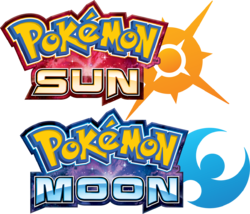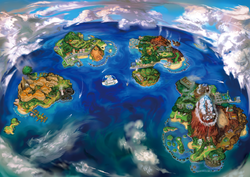Generation VII

|
The subject of this article has no official name. The name currently in use is a fan designator; see below for more information. |

|
This article is incomplete. Please feel free to edit this article to add missing information and complete it. |
| Generation VII | ||||||||||||||||||||||
|---|---|---|---|---|---|---|---|---|---|---|---|---|---|---|---|---|---|---|---|---|---|---|
| ||||||||||||||||||||||
| ||||||||||||||||||||||
The seventh generation (Japanese: 第七世代 seventh generation) of Pokémon games is the seventh installment of the Pokémon video game series starting with Pokémon Sun and Moon. Like Generation VI, the games of the seventh generation are presented on the Nintendo 3DS.
History
The seventh generation of Pokémon was announced with the reveal of Pokémon Sun and Moon on February 27, 2016, the Pokémon 20th Anniversary. These games were released worldwide on November 18, 2016, except in Europe where they were released on November 23, 2016.
The Generation VII games are not isolated from previous iterations and can communicate with both the Generation VI games and the Generation I Virtual Console re-releases through an online application known as Pokémon Bank. Through Pokémon Bank, Poké Transporter, Poké Transfer, and Pal Park, Pokémon all the way from Generation III can be transferred to Generation VII.
Advances in gameplay
- The addition of 81 new Pokémon, bringing the total to 802.
- The addition of 80 new moves.
- The addition of 41 new Abilities.
- A new region to explore, the Alola region, based on Hawaii.
- A new villainous team, Team Skull.
- Several Generation I Pokémon have a form unique to Alola known as a regional variant; this aspect of Generation VII is based on selective pressures which occur in the real world.
- The player can move freely in any direction, as opposed to the eight-directional grid of the previous generation.
- The addition of the Rotom Pokédex, a special Pokédex inhabited by a Rotom that doubles as a real-time map on the bottom screen of the Nintendo 3DS.
- The 3D models used for characters on the overworld are refined, and Trainers can be seen behind their Pokémon during battle, similar to Pokémon Colosseum, XD: Gale of Darkness, and Battle Revolution.
- Certain NPC trainers may keep their Pokémon in Poké Balls other than the standard Poké Ball.
- A new battle mechanic, Z-Moves, powerful moves that Pokémon can learn and perform once per battle.
- The addition of the island challenge, a traditional rite in the Alola region involving trials guided by Trial Captains, battling Totem Pokémon, and battles with Island Kahunas.
- The introduction of Greninja's Ash-Greninja form and Zygarde's four alternate forms, previously shown in the XY&Z arc of the anime's XY series.
- Two new battle modes:
- A battle that takes part between four Trainers called a Battle Royal, where each participating Trainer aims to defeat each other. The battle ends when all of one Trainer's Pokémon are knocked out, with the winner being the Trainer who has the highest combined number of knockouts and number of remaining Pokémon.
- A battle where wild Pokémon can summon allies to assist them called an SOS Battle.
- The addition of a QR code scanner, which allows players to register Pokémon in their Pokédex and receive event Pokémon.
- The addition of Poké Rides, which allow players to summon Pokémon that they can ride to access otherwise inaccessible areas.
- The addition of Hyper Training, a system that allows players to exchange special Bottle Caps to maximize their the IVs of their Level 100 Pokémon.
- The addition of the Festival Plaza, a hub accessible from the menu that allows the player to interact with other players locally or via the internet, as well as access various shops similarly to Join Avenue.
- The addition of the Poké Pelago, an option accessible from the menu that allows the player to send Pokémon that are stored in a PC Box to various islands, allowing them to gather items, discover wild Pokémon, and even raise their levels and stats.
Region
Alola
- Main article: Alola
The Alola region was introduced in Pokémon Sun and Moon. This island region is made up of four main islands and one artificial island.
Starter Pokémon
The starters of the seventh Generation follow the traditional Grass/Fire/Water trio setup. At the beginning of the game, the player must choose between the Grass and Flying-type Rowlet, the Fire-type Litten and the Water-type Popplio.
Trivia
- Generation VII is the only generation in which:
- There are no Gym Leaders, Gyms, and Badges.
- Bicycles and Gates do not appear.
- A Legendary Pokémon that is part of an evolutionary family was introduced.
- Generation VII is also the only generation that did not introduce:
- A Gym Leader or Elite Four member specializing in:
- Ice-type Pokémon.
- Psychic-type Pokémon.
- A Champion that precedes the player.
- A Gym Leader or Elite Four member specializing in:

|
This game-related article is part of Project Games, a Bulbapedia project that aims to write comprehensive articles on the Pokémon games. |

